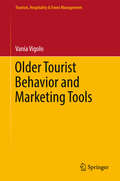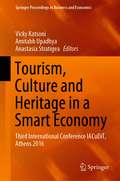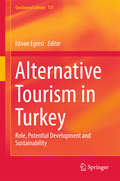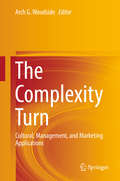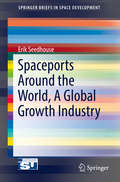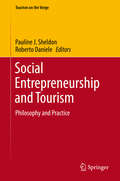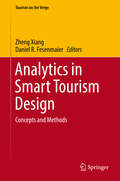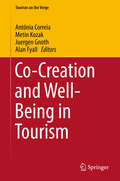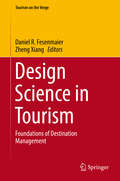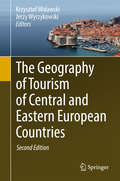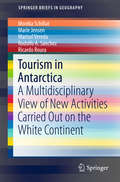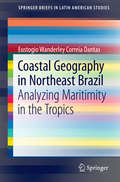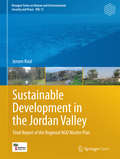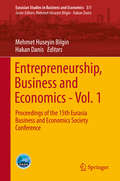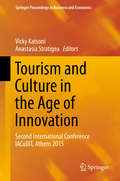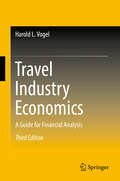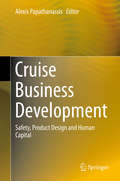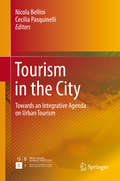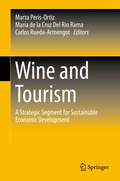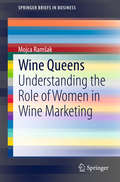- Table View
- List View
Older Tourist Behavior and Marketing Tools (Tourism, Hospitality & Event Management)
by Vania VigoloThis book provides an in-depth analysis of the older-tourist market, and of the challenges and opportunities created by population ageing from a tourism marketing perspective, by combining a demand-side and a supply-side approach to older tourists. The book is divided into three parts, the first of which defines older tourists and presents a critical review of segmentation approaches. The second part then focuses on the behavior of older tourists in terms of the travel planning process, the use of information and communication technologies for travel purposes, and accommodation choices. The final part analyzes the marketing strategies and operative practices of three tourism companies that focus on the older-adult market. Practical implications for tourism suppliers willing to target older tourists are derived. The book is intended primarily for academics, researchers, and professionals in the tourism and hospitality industry. In addition, it will be useful for students attending advanced tourism and hospitality courses.
Tourism, Culture and Heritage in a Smart Economy: Third International Conference IACuDiT, Athens 2016 (Springer Proceedings in Business and Economics)
by Vicky Katsoni Amitabh Upadhya Anastasia StratigeaThis book explores the ways in which information and communication technologies (ICTs) offer a powerful tool for the development of smart tourism. Numerous examples are presented from across the entire spectrum of cultural and heritage tourism, including art, innovations in museum interpretation and collections management, cross-cultural visions, gastronomy, film tourism, dark tourism, sports tourism, and wine tourism. Emphasis is placed on the importance of the smart destinations concept and a knowledge economy driven by innovation, creativity, and entrepreneurship. New modes of tourism management are described, and tourism products, services, and strategies for the stimulation of economic innovation and promotion of knowledge transfer are outlined. The potential of diverse emerging ICTs in this context is clearly explained, covering location-based services, internet of things, smart cities, mobile services, gamification, digital collections and the virtual visitor, social media, social networking, and augmented reality. The book is edited in collaboration with the International Association of Cultural and Digital Tourism (IACuDiT) and includes the proceedings of the Third International Conference on Cultural and Digital Tourism.
Alternative Tourism in Turkey: Role, Potential Development and Sustainability (GeoJournal Library #121)
by Istvan EgresiThis book takes inventory of and evaluates the available resources for the development of alternative tourism in Turkey. It examines the role of alternative tourism in future tourism development plans and proposes public policies necessary to assure sustainability. Although tourism started later in Turkey than in the Western Mediterranean countries it has grown very rapidly during the last three decades and today the country ranks among the top ten countries in the world in terms of both arrivals and receipts. However, most of the tourism development has been in the mass tourism sector or the so-called sun-sea-sand tourism. While crucial for the economic development of Turkey, mass tourism, in the absence of proper planning, has happened in a haphazard manner leading to numerous environmental and socio-cultural problems. This book argues that, in order to mitigate these problems, Turkey should encourage the development of alternative forms of tourism.
The Complexity Turn: Cultural, Management, and Marketing Applications
by Arch G. WoodsideThis book takes the reader beyond net effects and main and interaction effects thinking and methods. Complexity theory includes the tenet that recipes are more important than ingredients—any one antecedent (X) condition is insufficient for a consistent outcome (Y) (e.g., success or failure) even though the presence of certain antecedents may be necessary. A second tenet: modeling contrarian cases is useful because a high or low score for any given antecedent condition (X) associates with a high Y, low Y, and is irrelevant for high/low Y in some recipes in the same data set. Third tenet: equifinality happens—several recipes indicate high/low outcomes.
Spaceports Around the World, A Global Growth Industry (SpringerBriefs in Space Development)
by Erik SeedhouseThis brief presents a concise description of the existing spaceport market, the technologies being tested and developed at them, and the private companies that are making them possible. While NASA has its own plan for the future of space exploration, one that includes a new shuttle, an interplanetary spacecraft, and astronauts going to Mars, many people believe that the real future of space exploration is currently centered around dozens of commercial spaceports, financed by entrepreneurs inspired not only by profit but by the dream of creating a new space age, one not limited by bureaucracies or by budget allocations.Commercial spaceports in Florida, Texas, Oklahoma, Virginia and Alaska, as well as in countries like Curaçao and Sweden, are becoming home to dozens of private aerospace companies and provide a place where cutting-edge technology can be developed, tested and launched into space. Based on original interviews with principles at the various companies involved and on-site observations at the Mojave Air and Space Port, the author traces the early days of the spaceport movement and outlines what lies ahead.
Airline Economics: An Empirical Analysis of Market Structure and Competition in the US Airline Industry
by Giovanni Alberto TabaccoThis book presents an original empirical investigation of the market structure of airline city pair markets, shedding new light on the workings of competitive processes between firms. Examining a cross-section of US airline city pairs, Tabacco proposes for the first time that the industry can be understood as a natural oligopoly, each airline market being dominated by one to three airline carriers regardless of market size. The author questions the extent to which airlines deliberately prevent head-to-head competition within city pair markets, and draws intriguing conclusions about competitive forces from the observed market structure. Uncovering some of the main corporate strategies of the airline industry, the book is of immediate relevance to industry managers and practitioners, as well as academic economists.
Airline Economics: An Empirical Analysis of Market Structure and Competition in the US Airline Industry
by Giovanni Alberto TabaccoThis book presents an original empirical investigation of the market structure of airline city pair markets, shedding new light on the workings of competitive processes between firms. Examining a cross-section of US airline city pairs, Tabacco proposes for the first time that the industry can be understood as a natural oligopoly, each airline market being dominated by one to three airline carriers regardless of market size. The author questions the extent to which airlines deliberately prevent head-to-head competition within city pair markets, and draws intriguing conclusions about competitive forces from the observed market structure. Uncovering some of the main corporate strategies of the airline industry, the book is of immediate relevance to industry managers and practitioners, as well as academic economists.
Social Entrepreneurship and Tourism: Philosophy and Practice (Tourism on the Verge)
by Pauline J. Sheldon Roberto DanieleThis volume explores the links between the rapidly growing phenomenon of social entrepreneurship (SE) and the international tourism and hospitality industry. This unique industry is particularly ripe for transformation by SE and the book’s authors delve deeply into the reasons for this. The book has three parts. The first creates a conceptual and theoretical framework for understanding the uniqueness of SE in the tourism context. The second examines different communities of practice where SE is being applied in tourism. The third is a rich collection of case studies from eight countries where tourism SE is already having an impact. The book’s authors address the topic from many different angles, disciplinary backgrounds and geographic areas. Many case study authors are practicing social entrepreneurs who share their successes, challenges and experience with tourism-related projects. The book also proposes a research agenda and educational programmatic changes needed to support tourism SE. As these are developed, tourism SE will bring innovation to destinations, transformation of their economic and social structures, and contribution to a better world. The book has many insights and resources for scholars and practitioners alike to usher in this transformation.
Analytics in Smart Tourism Design: Concepts and Methods (Tourism on the Verge)
by Zheng Xiang Daniel R. FesenmaierThis book presents cutting edge research on the development of analytics in travel and tourism. It introduces new conceptual frameworks and measurement tools, as well as applications and case studies for destination marketing and management. It is divided into five parts: Part one on travel demand analytics focuses on conceptualizing and implementing travel demand modeling using big data. It illustrates new ways to identify, generate and utilize large quantities of data in tourism demand forecasting and modeling. Part two focuses on analytics in travel and everyday life, presenting recent developments in wearable computers and physiological measurement devices, and the implications for our understanding of on-the-go travelers and tourism design. Part three embraces tourism geoanalytics, correlating social media and geo-based data with tourism statistics. Part four discusses web-based and social media analytics and presents the latest developments in utilizing user-generated content on the Internet to understand a number of managerial problems. The final part is a collection of case studies using web-based and social media analytics, with examples from the Sochi Olympics on Twitter, leveraging online reviews in the hotel industry, and evaluating destination communications and market intelligence with online hotel reviews. The chapters in this section collectively describe a range of different approaches to understanding market dynamics in tourism and hospitality.
Co-Creation and Well-Being in Tourism (Tourism on the Verge)
by Antónia Correia Metin Kozak Juergen Gnoth Alan FyallThis book offers a wealth of new views and interpretations of well-being in tourism, emphasizing the role that co-creation – the creation or enhancement of value through tourist engagement with tourism providers and other tourists – is increasingly playing in enriching tourist experiences. A combination of theoretical and empirically based contributions relating to various tourism contexts shed light on existing and potential contributions of tourists and destination providers to tourist well-being. Readers will find novel and compelling insights into both the very nature of wellbeing as perceived by the tourist and the opportunities that are emerging as tourists become savvy decision-makers capable of activating their own networks and resources in order to shape their experiences. The book will be of interest for all who wish to learn more about the character and the construction of well-being within tourism, the relationship of well-being to a range of factors, and the ways in which tourism operators can assist tourists in creating high-value experiences.
Design Science in Tourism: Foundations of Destination Management (Tourism on the Verge)
by Daniel R. Fesenmaier Zheng XiangThis book explores the impact of design science and design thinking on tourism planning, gathering contributions from leading authorities in the field of tourism research and providing a comprehensive and interconnected panorama of cutting-edge results that influence the current and future design of tourist destinations. The book builds on recent findings in psychology, geography and urban and regional planning, as well as from economics, marketing and communications, and explores the opportunities arising from recent advances in the Internet and related technologies like memory, storage, RFID, GIS, mobile and social media in the context of collecting and analyzing traveler-related data. It presents a broad range of insights and cases on how modern design approaches can be used to develop new and better touristic experiences, and how they enable the tourism industry to track and communicate with visitors in a more meaningful way and more effectively manage visitor experiences.
Evolution of Destination Planning and Strategy: The Rise of Tourism in Croatia
by Larry Dwyer Renata Tomljenović Sanda ČorakThis book deals broadly with tourism planning and development from the perspective of Croatia, a major Adriatic tourism destination which is fast becoming one of the most popular vacation spots in the European Union. With the recent accession of Croatia to the EU, Croatia is undergoing a rapid political and economic transition and generating scholarly interest in the country’s primary, secondary, and tertiary industries. This book examines the country’s long history and thriving success in the tourism industry through issues of destination image and identity, management challenges, economic impact, and how to attract tourists in the midst of extreme political changes.The book explores the implications of policy decisions on product development and takes a theoretically sound approach to destination planning and problem-solving in Croatia. Its timely view of Croatian national tourism policy and the broader Adriatic/Mediterranean region makes this book of interest to all scholars, students, and practitioners engaged in various aspects of destination development planning and management.
Evolution of Destination Planning and Strategy: The Rise of Tourism in Croatia
by Larry Dwyer Renata Tomljenović Sanda ČorakThis book deals broadly with tourism planning and development from the perspective of Croatia, a major Adriatic tourism destination which is fast becoming one of the most popular vacation spots in the European Union. With the recent accession of Croatia to the EU, Croatia is undergoing a rapid political and economic transition and generating scholarly interest in the country’s primary, secondary, and tertiary industries. This book examines the country’s long history and thriving success in the tourism industry through issues of destination image and identity, management challenges, economic impact, and how to attract tourists in the midst of extreme political changes.The book explores the implications of policy decisions on product development and takes a theoretically sound approach to destination planning and problem-solving in Croatia. Its timely view of Croatian national tourism policy and the broader Adriatic/Mediterranean region makes this book of interest to all scholars, students, and practitioners engaged in various aspects of destination development planning and management.
The Geography of Tourism of Central and Eastern European Countries
by Krzysztof Widawski Jerzy WyrzykowskiThis book presents a comprehensive overview of the tourism market development in Central and Eastern European countries. It is divided into 13 chapters, including a chapter dedicated to Belarus, all richly illustrated with colorful maps and illustrations. The book presents the output of international conferences organized every two years by the Department of Regional Geography and Tourism of the University of Wroclaw which have served as inspiration for this book. Chapter 1 provides the characteristics of 20 post-communist countries of the region on the international tourism market and it sets the background and context for the following chapters. Chapters 2 to 13 present the condition of research on tourism, tourist attractions, tourist infrastructure, tourism movement, main types of tourism as well as tourist regionalization in 12 Central and Eastern European countries. All chapters have been updated with reference to the statistics.This book is a revised and updated version of “The Geography of Tourism of Central and Eastern Europe Countries” published by the Department of Regional Geography and Tourism of Wroclaw University in 2012. It has been developed by a group of specialists through their exchange of research experience in the scope of international tourism in Central and Eastern Europe.
Tourism in Antarctica: A Multidisciplinary View of New Activities Carried Out on the White Continent (SpringerBriefs in Geography #7)
by Monika Schillat Marie Jensen Marisol Vereda Rodolfo A. Sánchez Ricardo RouraThis book discusses the expansion of new activities carried out in Antarctica and the focus among treaty parties on the perceived challenges posed by adventure tourism in the region. Shedding light on the latest trends and the modus operandi of all parties involved, it draws attention to new elements in the debate on how tourism and environmental protection can best be reconciled, with tourism in Antarctica rapidly increasing in recent decades. As far as technical practice and visitor guidance are concerned, the challenge facing tour operators lies in determining whether tourism has a negative or positive impact on the environment. The individual chapters address the development of polar tourism in terms of numbers, types and activities. The International Association of Antarctica Tour Operators, which advocates and promotes the practice of safe and environmentally responsible travel to the Antarctic, is also part of this study. In this context, special attention is paid to its strategies relating to adventure tourism – including both deep-field activities and those additional or new activities launched from traditional ship or yacht-based platforms. The analysis includes aspects of risk management and environmental considerations, as well as views on the cultural perspectives of Antarctica.
Coastal Geography in Northeast Brazil: Analyzing Maritimity in the Tropics (SpringerBriefs in Latin American Studies)
by Eustogio Wanderley Correia DantasThis book studies the transformation of modern maritimity practices in coastal areas (such as swimming, navigation and tourism) and their implications to the development of Brazilian coastal cities, with an emphasis on the Northeast part of the country. It is a reflection on coastal geography in the tropics and the contemporary valorization of coastal cities from a socioeconomic, technological and symbolical point of view. The book highlights local fluxes on a regional and local scale, showing the incorporation of beach zones to spaces which were previously associated with so called traditional coastal practices (fishing activities and as harboring points). This book is dedicated to geography researchers and students.
Sustainable Development in the Jordan Valley: Final Report of the Regional NGO Master Plan (Hexagon Series on Human and Environmental Security and Peace #13)
by Jeroen KoolThis book summarizes the NGO Master Plan that provides a comprehensive program to rehabilitate the Lower Jordan River and its tributaries in Jordan, Israel and Palestine. It is a regional and civil society effort designed to promote the restoration of the valley’s environmental and ecological values within a realistic financial and economic framework. The plan identifies 127 specific regional and national "interventions"(projects) until the year 2050, based on seven strategic planning objectives: pollution control, sustainable water management and river rehabilitation, sustainable agriculture, Jordan River basin governance, ecological rehabilitation, sustainable tourism and cultural heritage development, and urban and infrastructure development. The total investment value is 4.58 billion USD, the plan ranks the interventions and identifies their feasibility in a short, medium and long term investment cycles considering the political environment.
Information and Communication Technologies in Tourism 2016: Proceedings of the International Conference in Bilbao, Spain, February 2-5, 2016
by Alessandro Inversini Roland ScheggThe papers presented in this volume advance the state-of-the-art research on digital marketing and social media, mobile computing and responsive web design, semantic technologies and recommender systems, augmented and virtual reality, electronic distribution and online travel reviews, MOOC and eLearning, eGovernment and sharing economy. This book covers the most significant areas contributed by prominent scholars from around the world and is suitable for both academics and practitioners who are interested in the latest developments in eTourism.
Entrepreneurship, Business and Economics - Vol. 1: Proceedings of the 15th Eurasia Business and Economics Society Conference (Eurasian Studies in Business and Economics #3/1)
by Mehmet Huseyin Bilgin Hakan DanisThis volume of Eurasian Studies in Business and Economics focuses on latest results from entrepreneurship and SME research, Human Resources, along with a focus on the Tourism industry. The first part deals with topics ranging from entrepreneurial intentions, social entrepreneurship and technological entrepreneurship to EU policies such as the 7th Framework program. Bridging the themes, the second part on Human Resources and General Management deals with human capital issues, labor force education, employer branding and aligning HR practices to knowledge management outcomes. The third part in particular concentrates on the tourism industry in exploring innovative marketing strategies, WEB 2.0 Challenges, tourism product innovation, and success in international markets.
Tourism and Culture in the Age of Innovation: Second International Conference IACuDiT, Athens 2015 (Springer Proceedings in Business and Economics)
by Vicky Katsoni Anastasia StratigeaThis book focuses on cultural tourism as it develops into the second decade of the new millennium. It presents recent hospitality and tourism research findings from various sources, including academic researchers and scholars, industry professionals, government and quasi-government officials, and other key industry practitioners. It discusses the latest tourism industry trends and identifies gaps in the research from a pragmatic and applied perspective. It includes specific chapters on innovation in tourism, the virtual visitor, cross-cultural visions of digital collections, heritage and museum management in the digital era, cultural and digital tourism policy, marketing and governance, social media, emerging technologies and e-tourism and many other topics of contemporary significance in global hospitality and tourism. The book is edited in collaboration with the International Association of Cultural and Digital Tourism (IACuDiT) and includes the proceedings of the Second International Conference on Cultural and Digital Tourism.
Travel Industry Economics: A Guide for Financial Analysis
by Harold L. VogelIn this book Harold L. Vogel comprehensively examines the business economics and investment aspects of major components of the travel industry, including airlines, hotels, casinos, amusement and theme parks and tourism. The book is designed as an economics-grounded text that uniquely integrates a review of each sector's history, economics, accounting, and financial analysis perspectives and relationships. As such, it provides a concise, up-to-date reference guide for financial analysts, economists, industry executives, legislators and regulators, and journalists interested in the economics, financing and marketing of travel and tourism related goods and services. The third edition of this well-established text updates, refreshes, and significantly broadens the coverage of tourism economics. It further includes new sections on power laws and price-indexing effects and also introduces new charts comparing airline and hotel revenue changes and lodging revenue changes in relation to GDP.
Cruise Business Development: Safety, Product Design and Human Capital
by Alexis PapathanassisThis book addresses innovation management and product development in the cruise tourism industry. It explains how experience management has evolved from a strictly company-level, product- or service-focused tactical task to an industry-wide strategic challenge, and analyses the role of intangible reputational aspects of cruise experiences, as well as peripheral components and stakeholders, as increasingly important factors for customer acquisition and retention. Safety and risk issues are a central theme, as well as the cruise sector’s environmental and socio-economic impacts. Lastly, the book considers the increasing size of cruise vessels and the accompanying standardisation of facilities and itineraries, in conjunction with the hybridisation of cruise passengers in connection with expanding the competitive boundaries and intensity of competition in the cruise sector. The book approaches these issues as more than a mere public relations campaign, recognising the fact that they have since become the very essence of strategic cruise business development.
Tourism in the City: Towards an Integrative Agenda on Urban Tourism
by Nicola Bellini Cecilia PasquinelliThis book critically explores the interconnections between tourism and the contemporary city from a policy-oriented standpoint, combining tourism perspectives with discussion of urban models, issues, and challenges. Research-based analyses addressing managerial issues and evaluating policy implications are described, and a comprehensive set of case studies is presented to demonstrate practices and policies in various urban contexts. A key message is that tourism policies should be conceived as integrated urban policies that promote tourism performance as a means of fostering urban quality and the well-being of local communities, e.g., in terms of quality spaces, employment, accessibility, innovation, and learning opportunities. In addition to highlighting the significance of urban tourism in relation to key urban challenges, the book reflects on the risks and tensions associated with its development, including the rise of anti-tourism movements as a reaction to touristification, cultural commodification, and gentrification. Attention is drawn to asymmetries in the costs and benefits of the city tourism phenomenon, and the supposedly unavoidable trade-off between the interests of residents and tourists is critically questioned.
Wine and Tourism: A Strategic Segment for Sustainable Economic Development
by Marta Peris-Ortiz María Cruz Del Río Rama Carlos Rueda-ArmengotThe aim of this book is to show how wine tourism can be used as a model for sustainable economic development, driving economic growth and social development in some locations. It will explore the interaction between tourism and viticulture in wine tourism destinations, while also explaining some of the repercussions of these activities. This book covers various topics including regional development, environmental management, sustainable viticulture, quality management in wineries and wine tourism routes among others.Wine tourism, which combines two important yet distinct economic activities (i.e., tourism and viticulture), has recently emerged as a new tourism product driven by tourists’ search for new experiences and wineries’ need to diversify their businesses and seek new revenue streams to boost sales. This new form of tourism, which typically takes place in rural areas and which combines wine production with tourist activities, is becoming important for such regions by providing a complementary income source. It provides a model for sustainable economic development for these regions, which for various reasons may otherwise struggle to develop. Featuring cases and business implications from various locations, this book provides an important source of knowledge—both theoretical and practical—suitable to academics, scholars, researchers, and practitioners in the tourism sector and the wine industry.
Wine Queens: Understanding the Role of Women in Wine Marketing (SpringerBriefs in Business)
by Mojca RamšakThis book explores a fairly unique wine marketing topic by examining the role and historic function of Wine Queens and Wine Kings. The author charts the history of Wine Queens in Europe, the Americas and Asia, while also focusing on cases from Slovenia. The difference between Wine Queens and Beauty Queens is also described in light of marketing approaches used in the wine industry. The book concludes with a thoughtful chapter on the role of objectification of women in profit seeking.
